
HOME > COMMON EYE CONDITIONS
Recognizing the signs of ocular disease
- Difficulty adjusting to darkness
- Double vision
- Red eyes
- Crusty or swollen eyes
- Recurring pain in or around the eyes
- Excessive tearing or watering
- Very dry, itchy or burning eyes
- Loss of peripheral vision
- Dark spots in the center of your viewing area
- Change in color of the colored part of your eye
- Vision that suddenly becomes blurred or hazy
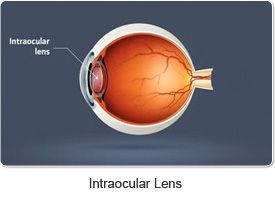
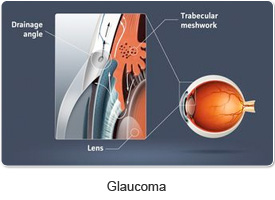
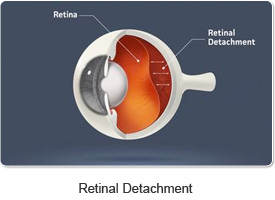
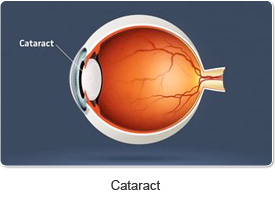
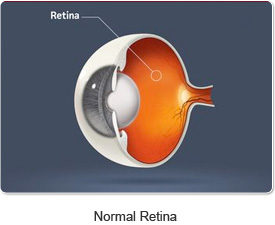
Understanding Eye Conditions
Allergies
Allergies are caused by an abnormal reaction of sensitive eyes to irritating substances; a response that can be triggered by nearly any substance in the eyes of different people. Common symptoms of allergies include itching, redness, watering, and swelling.
Amblyopia
See Lazy Eye
Astigmatism
Astigmatism is an irregular curvature of the lens or the cornea of the eye. Rather than being perfectly round, one meridian of the lens or cornea is steeper than the other. Astigmatism is very common and may accompany nearsightedness or farsightedness.
Blepharitis
Low-grade, chronic inflammation of the eyelid margins contributes to blepharitis. Common symptoms include redness, irritation, itching of eyelids, and dandruff-like flakes on the eyelashes.
Cataract
Cataracts occur in the lens of the eye located just behind the pupil. Over time, the lens becomes increasingly clouded, causing vision to become blurred and dim because light cannot easily pass through to the back of the eye. Cataracts can also contribute to problems with glare when driving at night.
Chalazion
A chalazion is caused by the blockage of an oil gland; it develops slowly into a firm, painless lump in the eyelid.
Color Vision Deficiency
Color vision deficiency is the inability to distinguish between certain shades of color. In more severe cases, people with color vision deficiency cannot see colors at all. The term “color blindness” is also used to describe this visual condition, but very few people are completely color blind.
Conjunctivitis
Conjunctivitis, commonly known as pink eye, is an inflammation of the conjunctiva, the clear membrane that covers the white part of the eye and the inner surface of the eyelids. Signs and symptoms include redness, irritation and swelling, itching, watering, or discharge depending on the cause. Conjunctivitis can be caused by viral or bacterial infections, allergies, or substances that irritate the eyes.
Convergence Insufficiency
The eyes must turn inward slightly, or converge, when reading or doing close work. For most people this happens automatically, but for those with convergence insufficiency, the eyes have difficulty converging and instead drift outward. This makes it difficult to focus up close, and can even cause headaches or double vision.
Corneal Abrasion
A corneal abrasion is a cut or scratch on the cornea, the clear front surface of the eye. Symptoms include pain, watering, blurred vision, and light sensitivity.
Crossed Eyes
When a patient’s eyes are crossed, the eyes do not point in the same direction. Coordination of the eyes is a complex process involving twelve different muscles that control where each eye is pointing. When there is an imbalance among these muscles, such as when one muscle is stronger or weaker than the others, the eyes do not maintain coordination and no longer point in the same direction. Crossed eyes can also happen when the prescription in one eye is much higher than the other.
Diabetic Retinopathy
Diabetes affects the eye in a number of ways. The most damaging consequence of diabetes occurs when the delicate blood vessels in the retina, the thin, light-sensitive nerve tissue lining the back of the eye, begin to leak fluid. This is known as diabetic retinopathy and exists in several different stages of severity. Left untreated, diabetic retinopathy can cause potentially permanent blurred vision, and, in extremely severe cases, even blindness. In most circumstances, the risk of developing diabetic retinopathy is directly correlated with the quality of a patient’s blood sugar control. Cataracts also develop earlier and progress more rapidly in patients with diabetes.
Dry Eye
In dry eye syndrome, the eye doesn’t produce enough tears, or the tears have an imbalance in their chemical composition that causes them to evaporate too quickly. Symptoms include burning, irritation, redness, blurred vision, and light sensitivity. Although it seems counterintuitive, watering can also be a symptom of dry eye because the eye is attempting to compensate for the imbalance in the tear composition.
Farsightedness
Farsightedness, or hyperopia, is a vision condition in which distant objects are usually seen clearly, but close objects do not come into proper focus. For patients with high levels of farsightedness, even distant objects can be blurry.
Floaters & Spots
Floaters appear as spots or shapes in your vision. To some people, they look like gnats, spider webs, or strands. Floaters form when pieces of the clear gel that fills the eye, called vitreous, break off and become mobile.
Glaucoma
Glaucoma occurs when the tissue of the optic nerve becomes damaged in a specific way. The optic nerve is located at the back of the eye and is responsible for carrying visual information to the brain. Damage to the optic nerve is usually observed as a thinning of the walls of the nerve and is often associated with increased pressure in the eye. Symptoms typically do not occur until late in the disease process when the damage is irreversible, and usually involve a loss of peripheral vision or even central vision in severe cases.
Hordeolum
See Stye
Hyperopia
See Farsightedness
Keratitis
Keratitis involves inflammation of the cornea, the front clear covering of the eye. This can occur due to the presence of a foreign object in the eye, an infection, dry eyes, or contact lens wear. Symptoms include pain, blurred vision, watering, light sensitivity, and discharge.
Keratoconus
Keratoconus involves progressive thinning and bulging of the cornea, the clear front surface of the eye. Symptoms include increasingly blurred or distorted vision.
Lazy eye is a general term for an eye that does not see clearly due to poor visual development or an eye that is turned in a different direction from the fellow eye. Unless a lazy eye is detected and treated early in life, glasses or contact lenses often do not fully correct the blurred vision.
Learning-related Vision Problems
When patients have difficulty focusing their vision for near work or experience an eye muscle imbalance, these visual abnormalities can make learning a struggle. Small muscles inside the eye allow vision to focus on near objects, but these muscles sometimes lack strength and flexibility, leading to blur and headaches. Eye muscle imbalances can cause eyestrain and even double vision. All of these visual symptoms make learning more strenuous and frustrating.
Macular Degeneration
Macular degeneration affects the macula, which is the central portion of the retina, the thin layer of nerve tissue lining the inside of the eye. The macula contains a dense population of light receptor cells that provide the sharp, detailed central vision needed for reading, driving, and other detailed activities. The delicate tissue of the macula can become damaged over time due to age-related changes in the function of the light receptor cells. The primary symptom of macular degeneration is blurred central vision that cannot be corrected with glasses or contacts.
Migraine with Aura
See Ocular Migraine
Myopia
See Nearsightedness
Patients who are nearsighted, or myopic, have blurred vision in the distance but can see near objects clearly.
Nystagmus
Nystagmus is an eye movement disorder in which the eyes make repetitive, uncontrolled movements, often resulting in reduced vision.
Ocular Hypertension
Ocular hypertension is diagnosed when patients have eye pressure measurements above the accepted normal range with no detectable changes in vision or damage to the optic nerve. Ocular hypertension can lead to glaucoma if left untreated.
Ocular Migraine
Ocular migraine refers to the benign visual symptoms that patients experience prior to a migraine. Common visual symptoms of an ocular migraine include colors, lights, and blurred or distorted vision. In some cases, patients experience only the visual symptoms and do not have a migraine afterward.
Pink Eye
See Conjunctivitis
Pinguecula
A pinguecula is a benign, fleshy growth of tissue on the conjunctiva, the clear membrane that covers the white part of the eye. For some patients, a pinguecula causes no symptoms, while others may experience redness and irritation.
Presbyopia
Presbyopia is an age-related vision condition in which the eyes gradually lose their ability to focus on near objects. This condition affects everyone, with symptoms typically starting between the ages of 40-45.
Pterygium
A pterygium is a benign, fleshy growth of tissue that affects both the conjunctiva, the clear membrane covering the white part of the eye, and an adjacent portion of the cornea, the front clear surface of the eye. Symptoms include redness, irritation, and blurred or distorted vision.
Ptosis
Ptosis refers to a drooping of the upper eyelid and can be caused by a nerve or muscle disorder.
Retinal Detachment
A retinal detachment is a rare but serious disorder in which the retina, the thin, delicate layer of nerve tissue lining the back of the eye, detaches from the wall of the eye. A retinal hole or tear often occurs prior to a detachment. This allows fluid to accumulate underneath the retina and separate the retina from the underlying tissue, similar to wallpaper peeling off a wall. Symptoms include flashing lights, floaters, vision loss, and the sensation of a curtain or veil descending over the field of vision. Retinal detachments can cause severe vision loss if not treated immediately.
Retinitis Pigmentosa
Retinitis pigmentosa refers to a group of inherited disorders of the retina, the thin, light-sensitive nerve tissue lining the back of the eye, that cause poor night vision and a progressive loss of side vision.
Retinoblastoma
Retinoblastoma is a rare type of cancerous eye tumor found in young children that develops in the retina, the light-sensitive nerve tissue lining the back of the eye. It is sometimes detected when parents notice a white pupil reflex in their child’s eye rather than the typical red reflex in a photograph. With timely diagnosis and treatment, the prognosis for children with retinoblastoma is excellent.
Strabismus
See Crossed Eyes
Stye
A stye, or hordeolum, is a common infection of an oil gland in the eyelid that causes a red, painful bump.
Subconjunctival Hemorrhage
When one of the delicate blood vessels traveling across the white part of the eye leaks or breaks, the blood accumulates underneath the conjunctiva, the clear membrane covering the white part of the eye. This is known as a subconjunctival hemorrhage. Similar to a bruise under the skin, a subconjunctival hemorrhage appears alarming but is usually a benign finding that will resolve on its own.
Uveitis
Uveitis refers to an inflammation of the middle layer of the eye called the uvea, which includes the iris and the internal focusing muscles. Symptoms include light sensitivity, achy pain in the eye and blurred vision. Uveitis can be associated with a number of systemic inflammatory conditions that affect the body as a whole.
** To better understand these conditions, we recommend you visit the American Optometric Association website.

